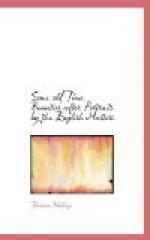“This youngest of the Graces
here we view
So like in Beauty to the other two
Whoe’er compares their Features
and their Frame
Will know at once that Gunning is
her name.”
There is an engraved picture of the two sisters together—based on Cotes’s portrayals—called “The Hibernian Sisters.” Maria is sitting on the left, looking toward the right, with a dog on her lap; the younger is on the right, looking to the front, and holds a fan in her hand. In the background is a garden wall. Cupids surmount the picture. The inscription is in this fashion:—
“Hibernia long with spleen
beheld
Her Favorite Toasts by ours excelled.
Resolved to outvie Britannia’s
Fair
By her own Beauties,—sent
a pair.”
Reynolds painted them both, in 1753; but he failed to give them the charm we would expect. Unless Sir Joshua’s engravers belie him, he did not make Maria even ordinarily fair to look upon. These pictures are not classed among his masterpieces. There is a picture of Maria by B. Wilson the engraver, made before she left Ireland. In it the features are handsome and the figure graceful, though over-dressed, and the whole impression is of a matron in her thirties rather than a maid in her teens. The picture we give of her is from a whole-length by Gavin Hamilton, a Scotch artist, a friend of Burns, born in Lanark about 1730. He must have been a precocious genius, for this picture was engraved by McArdell, and published in 1754. Hamilton passed the greater part of his life in Rome, painting classical subjects and pursuing archaeological investigations. He died there, in 1797. Portraiture was probably a pecuniary pursuit before the classics claimed him. His portraits savor somewhat of the affectations of the “curtain and column” school. His canvas of Elizabeth shows her standing on a terrace with a low dress and long hair, a veil loosely tied across her chest. Her left hand rests on the head of a greyhound. There is a seat to the left and trees in the background.




